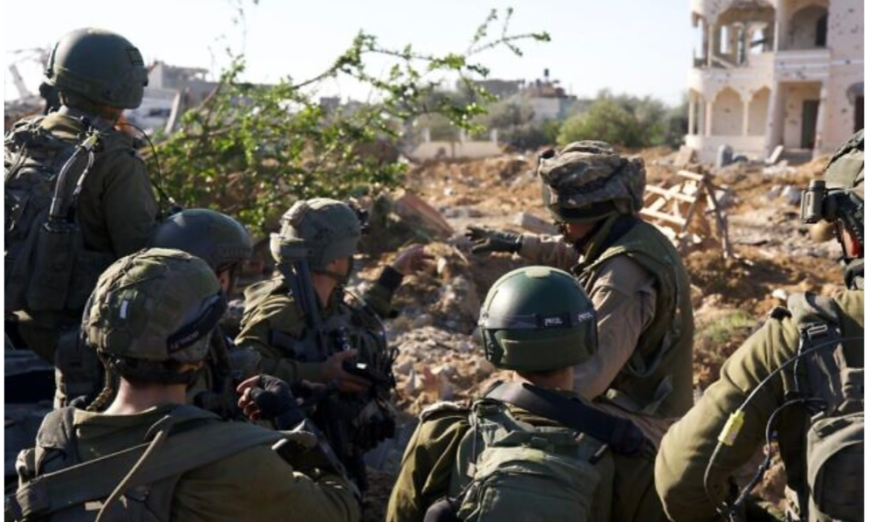Troops operate in the Gaza Strip in an undated photo released by the military on February 24, 2024 (Israel Defense Forces.)
Death of Maj. Eyal Shuminov, 24, takes army’s ground op toll to 238; visiting troops, IDF chief says military pressure is ‘most effective’ action to bring about a hostage deal.
Intense fighting continued over the weekend between Israeli troops and Palestinian terror operatives throughout the Gaza Strip, including Khan Younis in the south, Gaza City’s Zeitoun neighborhood in the north, and in the center of the Strip.
The Israel Defense Forces said many Hamas gunmen had been killed over the past day in all three theaters of operations.
And on Saturday evening, the military announced the death of an officer killed during fighting in northern Gaza over the weekend, bringing the toll of slain troops in the ground offensive against Hamas to 238.
He was named as Maj. Eyal Shuminov, 24, a company commander in the Givati Brigade’s Shaked Battalion, from Karmiel.
During a visit to northern Gaza, IDF Chief of Staff Lt. Gen. Herzi Halevi said military pressure on Hamas was “the most effective” action to bring about a potential hostage deal with the terror group, as talks were held in Paris on the latest proposals for an agreement.
“There is a connection between these things,” he said during an assessment with officers. “Your achievements — another battalion dismantled, more underground infrastructure [demolished], another neighborhood where [Hamas] infrastructure is destroyed and the population is evacuated to safety — all these things are pushing us, I very much hope, toward achieving the release of hostages.”
“This is a goal of war. We intend to do a great deal to realize it, and the fighting effort is the most effective action that helps those who are negotiating for the release of the hostages,” Halevi added.
The IDF also released footage showing airstrikes and tank shelling of Hamas operatives during operations in the Strip.
In western Khan Younis, the IDF said, paratroopers located a Hamas weapons depot with a large number of explosive devices, mines, grenades, ammunition, rockets and other military equipment.
Troops of the IDF’s 7th Armored Brigade raided the home of a senior Hamas intelligence officer in Khan Younis, locating a tunnel shaft and weapons nearby, the military said. The tunnel was later destroyed.
In the same area, the IDF said troops located a cache of mortars in repurposed bags from UN agency UNRWA, and other weapons and military equipment.
Amid the 7th Brigade’s operations in Khan Younis, the IDF said troops spotted eight Hamas operatives approaching them, before eliminating them with an Iron Sting guided mortar. It published footage of the strike.
Meanwhile, concern deepened Saturday over the growing humanitarian crisis in the war-torn enclave, with aid agencies warning of unprecedented levels of desperation and looming famine.
As civilians in the besieged territory struggled to get food and supplies, UNRWA warned Gazans were “in extreme peril while the world watches.”
In northern Gaza’s Jabaliya refugee camp, bedraggled children held plastic containers and battered cooking pots for what little food was available.
Food is running out, with aid agencies saying they are unable to get into the area because of Israeli strikes, while the trucks that do try to get through face frenzied looting.
Residents have taken to eating scavenged scraps of rotten corn, animal fodder unfit for human consumption, and even leaves.
The World Food Programme said this week its teams reported “unprecedented levels of desperation,” while the United Nations warned that 2.2 million people were on the brink of famine.
Israel has defended its track record on allowing aid into Gaza, saying that nearly 14,000 trucks carrying relief supplies had entered the territory since the start of the war.
Israel has also alleged that humanitarian organizations operating inside Gaza are failing to keep up with the pace, saying hundreds of trucks filled with aid sit idle on the Palestinian side of the Kerem Shalom Crossing. The UN, in turn, said it can’t always reach the trucks at the crossing because it is at times too dangerous.
Additionally, Israel has long accused Hamas of appropriating and stealing aid from an increasingly desperate civilian population.
At the same time, reports in Israel Saturday indicated cautious optimism among leaders on the prospects of reaching a temporary truce and hostage release deal with Hamas.
Channel 12 reported that war cabinet ministers were to vote by phone later on whether to endorse an outline proposed by international mediators in Paris for a hostages-for-truce outline.
It said the deal apparently provides, in a first phase, for the release of some 40 hostages in return for the release of hundreds of Palestinian security prisoners and a truce of some 6 weeks. These would be mostly female, elderly and ill hostages.
These details largely matched reports from other sources.
The war in Gaza began on October 7 with Hamas’s brutal attack on southern Israel, when thousands of Hamas-led terrorists went on a murderous rampage across local communities, killing 1,200 and taking 253 hostages.
The Hamas-run health ministry says nearly 30,000 Palestinians have been killed in Gaza since October 7. These figures cannot be independently verified and do not differentiate between civilians and terror operatives, or those killed by Hamas’s own rockets that exploded in the Strip. The IDF says it has killed some 12,000 terror operatives in Gaza, in addition to some 1,000 terrorists inside Israel on October 7.

